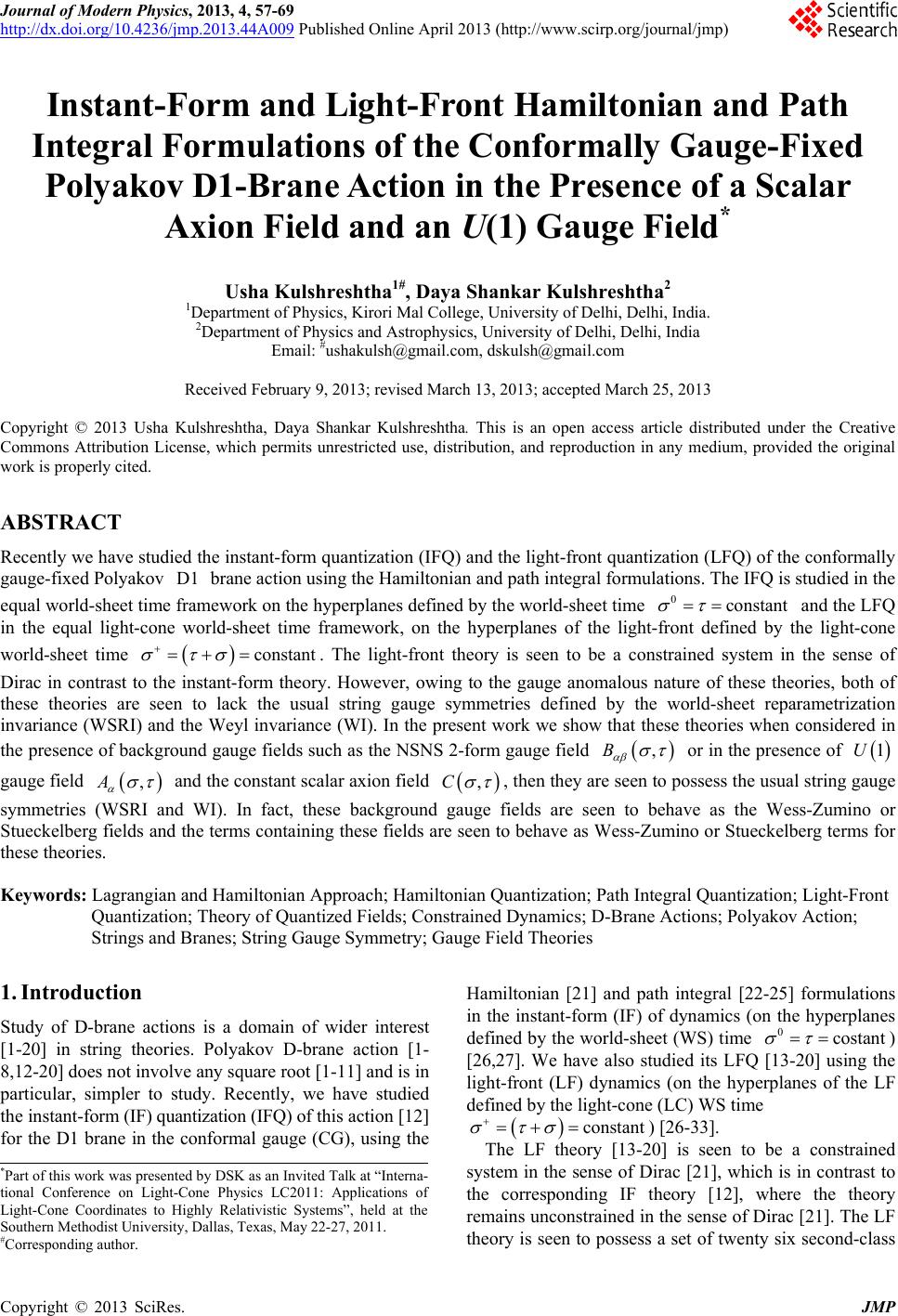 Journal of Modern Physics, 2013, 4, 57-69 http://dx.doi.org/10.4236/jmp.2013.44A009 Published Online April 2013 (http://www.scirp.org/journal/jmp) Instant-Form and Light-Front Hamiltonian and Path Integral Formulations of the Conformally Gauge-Fixed Polyakov D1-Brane Action in the Presence of a Scalar Axion Field and an U(1) Gauge Field* Usha Kulshreshtha1#, Daya Shankar Kulshreshtha2 1Department of Physics, Kirori Mal College, University of Delhi, Delhi, India. 2Department of Physics and Astrophysics, University of Delhi, Delhi, India Email: #ushakulsh@gmail.com, dskulsh@gmail.com Received February 9, 2013; revised March 13, 2013; accepted March 25, 2013 Copyright © 2013 Usha Kulshreshtha, Daya Shankar Kulshreshtha. This is an open access article distributed under the Creative Commons Attribution License, which permits unrestricted use, distribution, and reproduction in any medium, provided the original work is properly cited. ABSTRACT Recently we have studied the instant-form quantization (IFQ) and the light-front quantization (LFQ) of the conformally gauge-fixed Polyakov brane action using the Hamiltonian and path integral formulations. The IFQ is studied in the equal world-sheet time framework on the hyperplanes defined by the world-sheet time and the LFQ in the equal light-cone world-sheet time framework, on the hyperplanes of the light-front defined by the light-cone world-sheet time . The light-front theory is seen to be a constrained system in the sense of Dirac in contrast to the instant-form theory. However, owing to the gauge anomalous nature of these theories, both of these theories are seen to lack the usual string gauge symmetries defined by the world-sheet reparametrization invariance (WSRI) and the Weyl invariance (WI). In the present work we show that these theories when considered in the presence of background gauge fields such as the NSNS 2-form gauge field D1 constant constant 0 ,B or in the presence of 1U ,A gauge field ,C and the constant scalar axion field 0cost ant , then they are seen to possess the usual string gauge symmetries (WSRI and WI). In fact, these background gauge fields are seen to behave as the Wess-Zumino or Stueckelberg fields and the terms containing these fields are seen to behave as Wess-Zumino or Stueckelberg terms for these theories. Keywords: Lagrangi an an d Hamiltonian A pproach; Hamilt oni an Q uantization; Path Integral Quantizat i on; Light - F r o nt Quantization; Theory of Quantized Fields; Constrained Dynamics; D-Brane Actions; Polyakov Action; Strings and Branes; String Gau ge Symmetry; Gauge Field Theories 1. Introduction Study of D-brane actions is a domain of wider interest [1-20] in string theories. Polyakov D-brane action [1- 8,12-20] does not involve any square root [1-11] and is in particular, simpler to study. Recently, we have studied the instant-form (IF) q uantizati on (I FQ) of this action [12] for the D1 brane in the conformal gauge (CG), using the Hamiltonian [21] and path integral [22-25] formulations in the instant-form (IF) of dynamics (on the hyperplanes defined by the world-sheet (WS) time ) [26,27]. We have also studied its LFQ [13-20] using the light-front (LF) dynamics (on the hyperplanes of the LF defined by the light-cone (LC) WS time constant ) [26-33]. The LF theory [13-20] is seen to be a constrained system in the sense of Dirac [21], which is in contrast to the corresponding IF theory [12], where the theory remains unconstrained in the sense of Dirac [21]. The LF theory is seen to possess a set of twenty six second-class *Part of this work was presented by DSK as an Invited Talk at “Interna- tional Conference on Light-Cone Physics LC2011: Applications o Light-Cone Coordinates to Highly Relativistic Systems”, held at the Southern Methodist University, Dallas, Texas, May 22-27, 2011. #Corresponding author. C opyright © 2013 SciRes. JMP 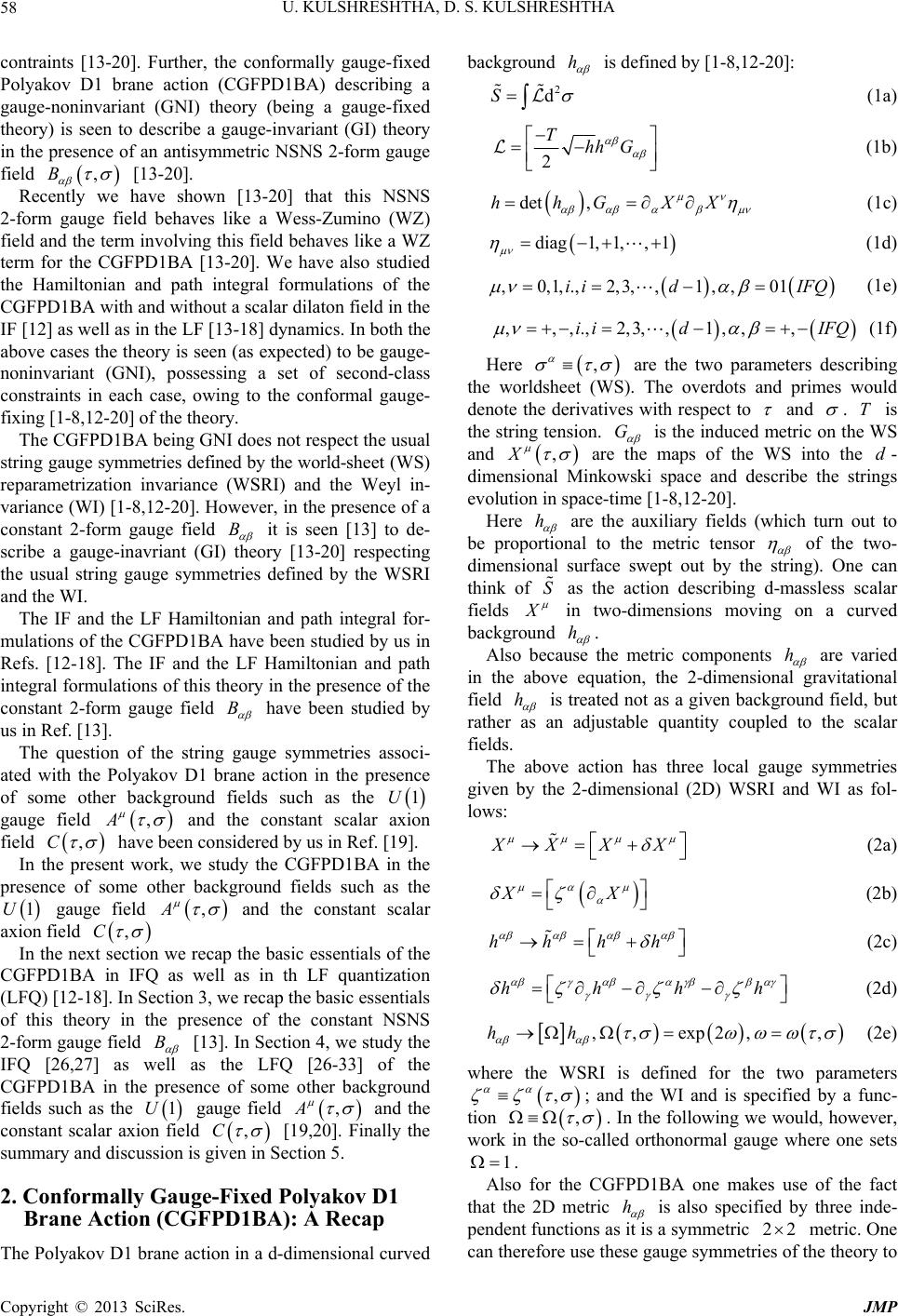 U. KULSHRESHTHA, D. S. KULSHRESHTHA 58 h contraints [13-20]. Further, the conformally gauge-fixed Polyakov D1 brane action (CGFPD1BA) describing a gauge-noninvariant (GNI) theory (being a gauge-fixed theory) is seen to describe a gauge-invariant (GI) theory in the pre sence of an antisymmetric NSNS 2-form gauge field ,B B [13-20]. Recently we have shown [13-20] that this NSNS 2-form gauge field behaves like a Wess-Zumino (WZ) field and the term involving this field behaves like a WZ term for the CGFPD1BA [13-20]. We have also studied the Hamiltonian and path integral formulations of the CGFPD1BA with and without a scalar dilaton field in the IF [12] as well as in the LF [13-18] dynamics. In both the above cases the theory is seen (as expected) to be gauge- noninvariant (GNI), possessing a set of second-class constraints in each case, owing to the conformal gauge- fixing [1-8, 12 - 20] of the theory. The CGFPD1BA being GNI does not respect the usual str ing gau ge symmetries defined by the world-sheet (W S) reparametrization invariance (WSRI) and the Weyl in- variance (WI) [1-8,12-20]. However, in the presence of a constant 2-form gauge field it is seen [13] to de- scribe a gauge-inavriant (GI) theory [13-20] respecting the usual string gauge symmetries defined by the WSRI and the WI. The IF and the LF Hamiltonian and path integral for- mulations of the CGFPD1BA have been studied by us in Refs. [12-18]. The IF and the LF Hamiltonian and path integral formulations of th is theory in the presence of the constant 2-form gauge field B have been studied by us in Ref. [13]. The question of the string gauge symmetries associ- ated with the Polyakov D1 brane action in the presence of some other background fields such as the 1 ,A U gauge field , and the constant scalar axion field C 1U ,A have been considered by us in Ref. [19]. In the present work, we study the CGFPD1BA in the presence of some other background fields such as the gauge field and the constant scalar axion field ,C B In the next section we recap the basic essentials of the CGFPD1BA in IFQ as well as in th LF quantization (LFQ) [12-18]. In Section 3, we recap the basic essentials of this theory in the presence of the constant NSNS 2-form gauge field [13]. In Section 4, we study the IFQ [26,27] as well as the LFQ [26-33] of the CGFPD1BA in the presence of some other background fields such as the gauge field 1U ,A and the constant scalar axion field ,C [19,20]. Finally the summ ar y and discussion is give n in Sectio n 5 . 2. Conformally Gauge-Fixed Polyakov D1 Brane Action (CGFPD1BA): A Recap The Polyakov D1 brane action in a d-dimensional curved background 2 dS is defined by [1-8,12-20]: (1a) 2 Thh G (1b) det ,hhG XX (1c) diag1, 1,, 1 (1d) ,0,1,.,2,3,,1,, 01ii dIFQ (1e) ,,,.,2,3,,1,,,ii dIFQ (1f) , Here are the two parameters describing the worldsheet (WS). The overdots and primes would denote the derivatives with respect to and . is the string tension. T G is the induced metric on the WS and ,X h are the maps of the WS into the d- dimensional Minkowski space and describe the strings evolution in space-time [1-8,12-20]. Here are the auxiliary fields (which turn out to be proportional to the metric tensor of the two- dimensional surface swept out by the string). One can think of as the action describing d-massless scalar fields S in two-dimensions moving on a curved background h Also because the metric components . h are varied in the above equation, the 2-dimensional gravitational field h is treated not as a given background field, but rather as an adjustable quantity coupled to the scalar fields. The above action has three local gauge symmetries given by the 2-dimensional (2D) WSRI and WI as fol- lows: XXX (2a) XX hhhh (2b) hhhh (2c) (2d) , ,exp2, ,hh (2e) where the WSRI is defined for the two parameters , ; and the WI and is specified by a func- tion , 1 . In the following we would, however, work in the so-called orthonormal gauge where one sets h . Also for the CGFPD1BA one makes use of the fact that the 2D metric is also specified by three inde- pendent functions as it is a symmetric metric. One can therefore use these gauge symmetries of the theory to 22 Copyright © 2013 SciRes. JMP 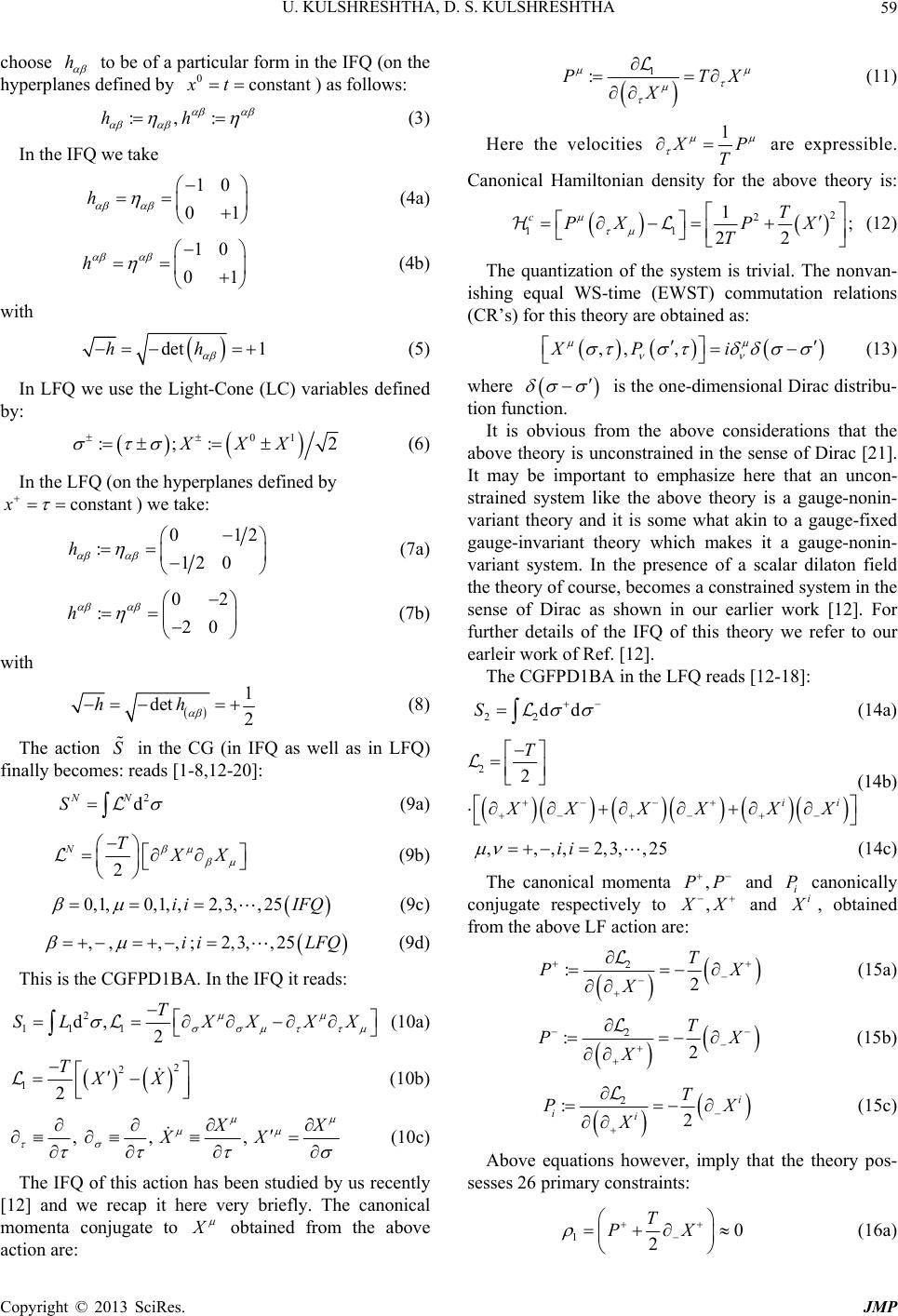 U. KULSHRESHTHA, D. S. KULSHRESHTHA 59 choose h to be of a particular form in the IFQ (on the hyperplanes defined by ) as follows: 0 :,h constantxt :h h 10 01 (3) In the IFQ we take 10 01 (4a) h (4b) with deth 1h (5) In LFQ we use the Light-Cone (LC) variables defined by: 012X constant :;:XX (6) In the LFQ (on the hyperplanes defined by ) we take: x 012 12 0 02 20 :h (7a) :h (7b) with 1 t2 hh S 2 d NN de (8) The action in the CG (in IFQ as well as in LFQ) finally becomes: reads [1-8,12-20]: S (9a) 2 NT X 0,1,0,1, ,2,3,,25ii IFQ ,3, ,25LFQ (9b) (9c) , ,,, ;2ii (9d) This is the CGFPD1BA. In the IFQ it reads: 2 d, T SLXX XX 11 1 2 (10a) 2 2 TXX 12 (10b) , , , X XX (10c) The IFQ of this action has been studied by us recently [12] and we recap it here very briefly. The canonical momenta conjugate to obtained from the above action are: 1 :PTX X (11) Here the velocities 1 P T are expressible. Canonical Hamiltonian density for the above theory is: 2 2 11 1; 22 cT PXP X T (12) The quantization of the system is trivial. The nonvan- ishing equal WS-time (EWST) commutation relations (CR’s) for this theory are obtained as: ,, ,XP i (13) where 22 ddS is the one-dimensional Dirac distribu- tion funct ion. It is obvious from the above considerations that the above theory is unconstrained in the sense of Dirac [21]. It may be important to emphasize here that an uncon- strained system like the above theory is a gauge-nonin- variant theory and it is some what akin to a gauge-fixed gauge-invariant theory which makes it a gauge-nonin- variant system. In the presence of a scalar dilaton field the theory of co ur se, becomes a constrained system in the sense of Dirac as shown in our earlier work [12]. For further details of the IFQ of this theory we refer to our earleir work of Ref. [12]. The CGFPD1BA in the LFQ reads [12-18]: (14a) 22 ii T XXXXX ,,,,2,3,,25ii (14b) ,PP i P , (14c) The canonical momenta and canonically conjugate respectively to X i and , obtained from the above LF action are: 2 :2 T PX X (15a) 2 :2 T PX X (15b) 2 :2 i ii T PX X (15c) Above equations however, imply that the theory pos- sesses 26 primary constraints: 10 2 T PX (16a) Copyright © 2013 SciRes. JMP 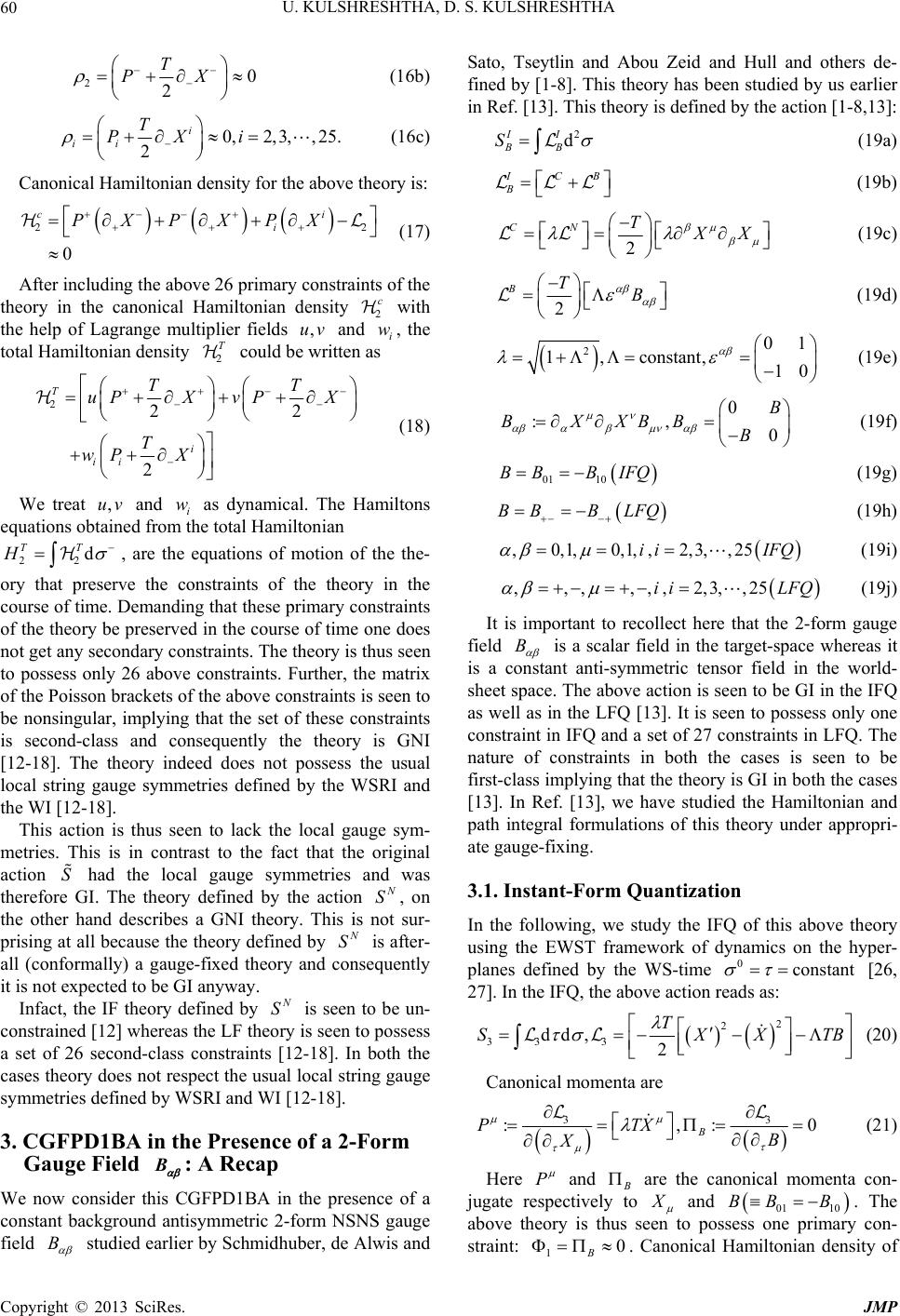 U. KULSHRESHTHA, D. S. KULSHRESHTHA 60 2P 0 2 TX (16b) 0, 2 i ii T PX 2,3, ,25. i 22 ci PX 2 c ,uv i w (16c) Canonical Hamiltonian density for the above theory is: 0 i PXPX (17) After including the above 26 primary constraints of the theory in the canonical Hamiltonian density with the help of Lagrange multiplier fields and , the total Hamiltonian density could be written as 2 T 2 2 T i ii 22 uP XvPX T wP X ,uv w 22 d TT TT (18) We treat and i as dynamical. The Hamiltons equations obtained from the total Hamiltonian H S , are the equations of motion of the the- ory that preserve the constraints of the theory in the course of time. Demanding that these primary constraints of the theory be preserved in the course of time one does not get any secondary constraints. The theory is thus seen to possess only 26 above constraints. Further, the matrix of the Poisson brackets of the above constraints is seen to be nonsingular, implying that the set of these constraints is second-class and consequently the theory is GNI [12-18]. The theory indeed does not possess the usual local string gauge symmetries defined by the WSRI and the WI [12-18]. This action is thus seen to lack the local gauge sym- metries. This is in contrast to the fact that the original action had the local gauge symmetries and was therefore GI. The theory defined by the action S, on the other hand describes a GNI theory. This is not sur- prising at all because the theory defined by S is after- all (conformally) a gauge-fixed theory and consequently it is not expected to be GI anyway. Infact, the IF theory defined by S is seen to be un- constrained [12] whereas the LF theory is seen to possess a set of 26 second-class constraints [12-18]. In both the cases theory does not respect the usual local string gauge symm e t r i e s defined by WSRI and WI [ 12-18]. 3. CGFPD1BA in the Presence of a 2-Form Gauge Field B : A Recap We now consider this CGFPD1BA in the presence of a constant background antisymmetric 2-form NSNS gauge field 2 d II BB S studied earlier by Schmidhuber, de Alwis and Sato, Tseytlin and Abou Zeid and Hull and others de- fined by [1-8]. This theory has been studied by us earlier in Ref. [13]. This theory is defined by the action [1-8,13]: (19a) CB B (19b) 2 CN T X (19c) 2 BTB (19d) 201 1,constant,10 0 :, 0 B BXXBB B (19e) (19f) 01 10 BB BIFQ (19g) BBB LFQ ,0 ,1,0 ,1, ,2 ,3,,25ii IFQ ,,, ,, ,2,3,,25ii LFQ B (19h) (19i) (19j) It is important to recollect here that the 2-form gauge field is a scalar field in the target-space whereas it is a constant anti-symmetric tensor field in the world- sheet space. The above action is seen to be GI in the IFQ as well as in the LFQ [13]. It is seen to possess only one constraint in IFQ and a set of 27 constraints in LFQ. The nature of constraints in both the cases is seen to be first-class implying that the theory is GI in both the cases [13]. In Ref. [13], we have studied the Hamiltonian and path integral formulations of this theory under appropri- ate gauge-fixing. 3.1. Instant-Form Quantization In the following, we study the IFQ of this above theory using the EWST framework of dynamics on the hyper- planes defined by the WS-time [26, 27]. In the IFQ, the above action reads as: 0constant 2 2 33 3 dd ,2 T SXXTB (20) Canonical momenta are 33 :,:0 B PTX B X P (21) and Here are the canonical momenta con- jugate respectively to and 0110. The above theory is thus seen to possess one primary con- straint: BB B 10 B . Canonical Hamiltonian density of Copyright © 2013 SciRes. JMP 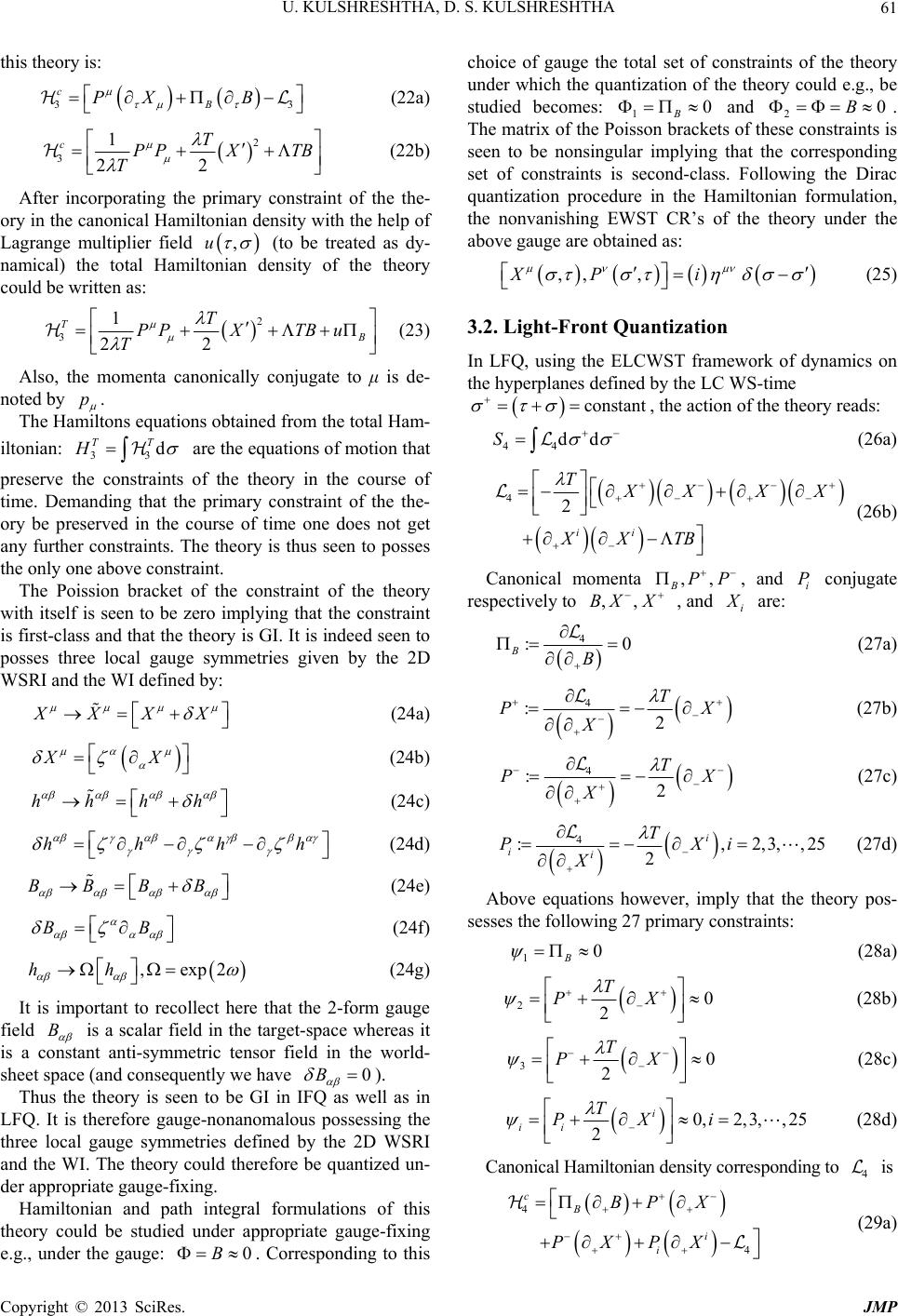 U. KULSHRESHTHA, D. S. KULSHRESHTHA 61 this theory is: 3 cPX 3BB (22a) 2 X TB ,u 31 22 cT PP T (22b) After incorporating the primary constraint of the the- ory in the canonical Hamilto nian density with th e help of Lagrange multiplier field (to be treated as dy- namical) the total Hamiltonian density of the theory could be written as: 2 31 22 T T PP X T TB u p (23) Also, the momenta canonically conjugate to μ is de- noted by . The Hamiltons equations obtained from the total Ham- iltonian: 33 d TT H are the equations of motion that preserve the constraints of the theory in the course of time. Demanding that the primary constraint of the the- ory be preserved in the course of time one does not get any further constraints. The theory is thus seen to posses the only one above constraint. The Poission bracket of the constraint of the theory with itself is seen to be zero implying that the constraint is first-class and that the theory is GI. It is indeed seen to posses three local gauge symmetries given by the 2D WSRI and the WI defined by: XXX XX hh hhhh (24a) (24b) hh (24c) BBBB (24d) B ,exp2hh (24e) B (24f) (24g) It is important to recollect here that the 2-form gauge field B is a scalar field in the target-space whereas it is a constant anti-symmetric tensor field in the world- sheet space (and consequently we have 0B 0B 0 ). Thus the theory is seen to be GI in IFQ as well as in LFQ. It is therefore gauge-nonanomalous possessing the three local gauge symmetries defined by the 2D WSRI and the WI. The theory could therefore be quantized un- der appropriate gauge-fixing. Hamiltonian and path integral formulations of this theory could be studied under appropriate gauge-fixing e.g., under the gauge: . Corresponding to this choice of gauge the total set of constraints of the theory under which the quantization of the theory could e.g., be studied becomes: 1B 0B and 2. The matrix of the Poisson brackets of th ese constraints is seen to be nonsingular implying that the corresponding set of constraints is second-class. Following the Dirac quantization procedure in the Hamiltonian formulation, the nonvanishing EWST CR’s of the theory under the above gauge are obtained as: ,,, XP i (25) 3.2. Light-Front Quantization In LFQ, using the ELCWST framework of dynamics on the hyperplanes defined by the LC WS-time constant 44 ddS , the action of the theory reads: (26a) 42 ii T XXX XXTB ,, PP i P ,, BX X (26b) Canonical momenta B, and conjugate respectively to i , and are: 4 :0 BB (27a) 4 :2 T PX X (27b) 4 :2 T PX X (27c) 4 :,2,3,,25 2 i ii T PXi X 10 B (27d) Above equations however, imply that the theory pos- sesses the following 27 primary constraints: (28a) 20 2 T PX (28b) 30 2 T PX (28c) 0,2,3, ,25 2 i ii T PXi 4 (28d) Canonical Hamiltonian density corresponding to is 4 4 c B i i BP X PXPX (29a) Copyright © 2013 SciRes. JMP  U. KULSHRESHTHA, D. S. KULSHRESHTHA 62 4 cTB 4 c ,,u v (29b) After including the primary constraints of the theory in the canonical Hamiltonian density with the help of Lagrange multiplier fields ,,s , and i , w (which we treat as dyna- mical), the total Hamiltonian density of the theory could be written as: 421 Tc su 23ii v w (30a) 4 2 2 T B i ii TB su P T vP X T wP X 2 TX 44 d TT (30b) Hamiltons equations obtained from the total Hamilto- nian H 0B are the equations of motion that preserve the constraints of the theory in the course of time. The matrix of the Poisson brackets of these above constraints is seen to be singular implying that the corre- sponding set of constraints is first-class and that the cor- responding theory is GI [13]. The above theory is indeed seen to possess three local gauge symmetries given by the 2D WSRI and the WI [13] and the theory could be quantized under appropriate guage-fixing. To study the Hamiltonian and path integral formulations of the theory under gauge-fixing, we could e.g., choose the gauge: 10B . corresponding to this gauge choice the total set of 28 constraints of the theory becomes [13]: 21 0 B (31a) (31b) 0 TX 32 2 P (31c) 0 T PX 43 2 (31d) 0,2,3, ,25 i ii i T PXi 2 0B (31e) The matrix of the Poisson brackets of the above 28 constraints is seen to be nonsingular implying that the corresponding set of constraints is second-class. Now following the Dirac quantization procedure in the Ham- iltonian formulation, the nonvanishing ELCWST CR’s of the theory under the gauge-fixing are ob- tained as [13]: ,,, 2 i i XP XP XP i (32a) ,, 2 ii i XX XXT (32b) ,, 4 ii iT PP PP 1 (32c) For further details of the Hamiltonian and path integral formulations of the above theory, we refer to our earlier work [13]. 4. CGFPD1BA in the Presence of a Scalar Axion Field C and an U(1) Gauge Field Aμ In this section, we study the IFQ and LFQ of the CGFPD1BA in the presence of a U gauge field ,AA and a constant scalar axion field ,CC 1 [19,20]. We find that the CGFPD1BA describing a GNI theory (being a gauge-fixed theory) is seen to describe a GI theory when considered in the presence of above background fields. ,A We also find that the U gauge field , and the constant scalar axion field C are both see n to behave like the Wess-Zumino (W Z) fi el ds [1 9, 20] and the term involving these fields in the action is seen to behave like a WZ term for the CGFPD1BA [13,19,20]. Here the field is a scalar field in the target space and a vector field in the WS space and the axion field C is a constant scalar field in both the target space as well as in the WS space [19,20]. We find that the resulting theory obtained in the above manner describes a GI system respecting the usual string gauge symmetries defined by the 2D WSRI and the WI. It is seen that the axion field and the C 1U gauge field , in the resulting theory behave like the WZ fields and the term involving these fields behaves like a WZ term for the CGFPD1BA [19]. The situation in the present case is seen to be exactly analogous to a theory where one considers the CGFPD- 1BA in the presence of a 2-form gauge field B as studied by us in our earlier work [13], where the field B behaves like a WZ field and the term involving this field behaves like a WZ term for the CGFPD1BA [13]. The CGFPD1BA in the presence of a constant back- ground scalar axion field and an U gauge field C 1 is defined by [1-8,19, 2 0] : 2 d II AA S (33a) CA A (33b) 2 CN T X (33c) 2 ATCF (33d) 2 1 , constant (33e) Copyright © 2013 SciRes. JMP  U. KULSHRESHTHA, D. S. KULSHRESHTHA 63 01 , 10 AA 01 (33f) 01 FFIFQ (33g) FFLFQ ,0,1, ,2,3,,25ii IFQ 2,3,,25LFQ 0constant , 0,1 (33h) (33i) ,,,,,,ii (33j) 4.1. Instant-Form Quantization In this section, we study the IF Hamiltonian and path integral quantization of the above theory using the EWST framework, on the hyperplanes defined by the WS-time . The IF action reads: 2 2 ,TXXTCf 55 ddS 52 (34) Overdots and primes denote derivatives with respect to and respectively. The canonical momenta ob- tained are: 5 :PTX X (35a) 5 : cC 0 (35b) 0 5 0 :0 A (35c) 15 1 :ETC A 1 ,, (35d) where and c are the canonical momenta conjugate respectively to 01 0 ,,PE AA 1 20ETC 30 c 0 50 15 c PXA EA C and C. The theory is thus seen to possess three primary con- straints: 0 0 (36a) (36b) (36c) Canonical Hamiltonian density corresponding to above Lagrangian density is: c (37a) 2 50 22 TXTCA ,, ,uv 1 cPP T and (37b) After incorporating the primary constraints of the the- ory in the canonical Hamiltonian density with the help of Lagrange multiplier fields ,w 55123 Tc uu w (treated as dynamical) the total Hamiltonian density of the theory becomes: (38a) 2 50 0 1 22 T c T PPX TCA T uE TCvw , uv pp w p 55 d TT H (38b) Momenta canonically conjugate to u, v and w are de- noted respectively by and . Hamiltons equa- tions obtained from the total Hamiltonian , for the closed string with periodic boundary conditions (BC’s) e.g., are: 5 5 1, T T H XP PT H PTX X (39a) 55 0 , TT C C HH Cw TAv C (39b) 0 55 000 ,0 TT HH Au A (39c) 55 11 ,0 TT HH AvE EA (39d) 0 55 0, TT u u HH up pu (39e) 55 0, TT v v HH vpETC pv (39f) 55 0, TT wC w HH wp pw , (39g) These are the equations of motion of the theory that preserve the constraints of the theory in the course of time. Demanding that the primary constraints of the the- ory be preserved in the course of time one does not get any further constraints. The theory is thus seen to posses only three constraint 12 and . 3 Matrix of the Poission brackets of these constraints is seen to be singular implying that the constraints form a set of first-class constraints and that the theory is GI (and consequently gauge-nonanomalous). It is indeed seen to posses three local gauge symmetries given by the 2D WSRI and the WI defined by: XXX (40a) Copyright © 2013 SciRes. JMP 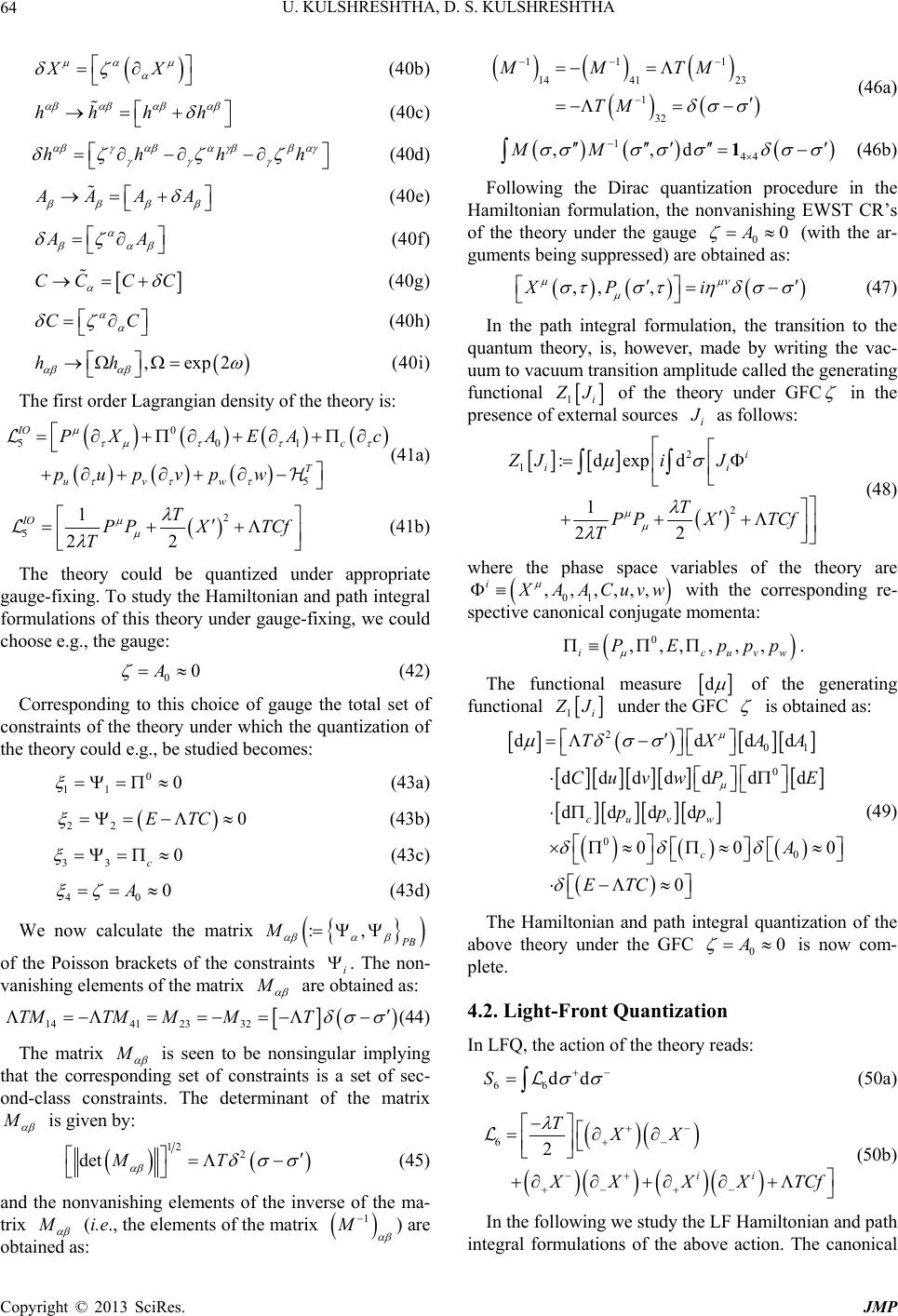 U. KULSHRESHTHA, D. S. KULSHRESHTHA 64 11 1 14 4123 1 32 MMTM TM XX hh hh (40b) hh (40c) hh (40d) AAA (40e) A (40f) CC CC C ,exp2hh (40g) C (40h) 0 501 5 c T AEA c (40i) The first order Lagrangian density of the theory is: IO PX uvw pu pvp w (41a) 2 51 22 IO T PPX TC T f 00A (41b) The theory could be quantized under appropriate gauge-fixing. To study the Hamiltonian and path integral formulations of this theory under gauge-fixing, we could choose e.g., the gauge: 0 11 0 22 0ETC 33 0 c (42) Corresponding to this choice of gauge the total set of constraints of the theory under which the quantization of the theory could e.g., be studied becomes: (43a) (43b) 0 0 (43c) 4 A :, (43d) We now calculate the matrix B M of the Poisson brackets of the constraints i. The non- vanishing elements of the matrix are obtained as: 14 41 TMTM 23 32 M MT (44) The matrix is seen to be nonsingular implying that the corresponding set of constraints is a set of sec- ond-class constraints. The determinant of the matrix is given by: 12 2 det MT (45) and the nonvanishing elements of the inverse of the ma- trix (i.e., the elements of the matrix 1 M ) are obtained as: (46a) 144 ,,dMM 1 0A (46b) Following the Dirac quantization procedure in the Hamiltonian formulation, the nonvanishing EWST CR’s of the theory under the gauge 0 (with the ar- guments being suppressed) are obtained as: ,, ,XP i (47) In the path integral formulation, the transition to the quantum theory, is, however, made by writing the vac- uum to vacuum transition amplitude called the generating functional 1i J of the theory under GFC in the presence of external sources i as follows: 2 1 2 :dexpd 1 22 i ii ZJi J T PPX TCf T (48) where the phase space variables of the theory are ,,,,,, i01 AACuvw with the corresponding re- spective canonical conjugate momenta: 0 ,,,,,, icuvw PEppp . The functional measure d of the generating functional 1i J under the GFC is obtained as: 201 0 00 dddd ddddd dd dddd 000 0 cuvw c TXAA CuvwPE ppp A ETC (49) 00A The Hamiltonian and path integral quantization of the above theory under the GFC 66 ddS is now com- plete. 4.2. Light-Front Quantization In LFQ, the action of the theory reads: (50a) 62 ii TXX XXXTCf (50b) In the following we study the LF Hamiltonian and path integral formulations of the above action. The canonical Copyright © 2013 SciRes. JMP 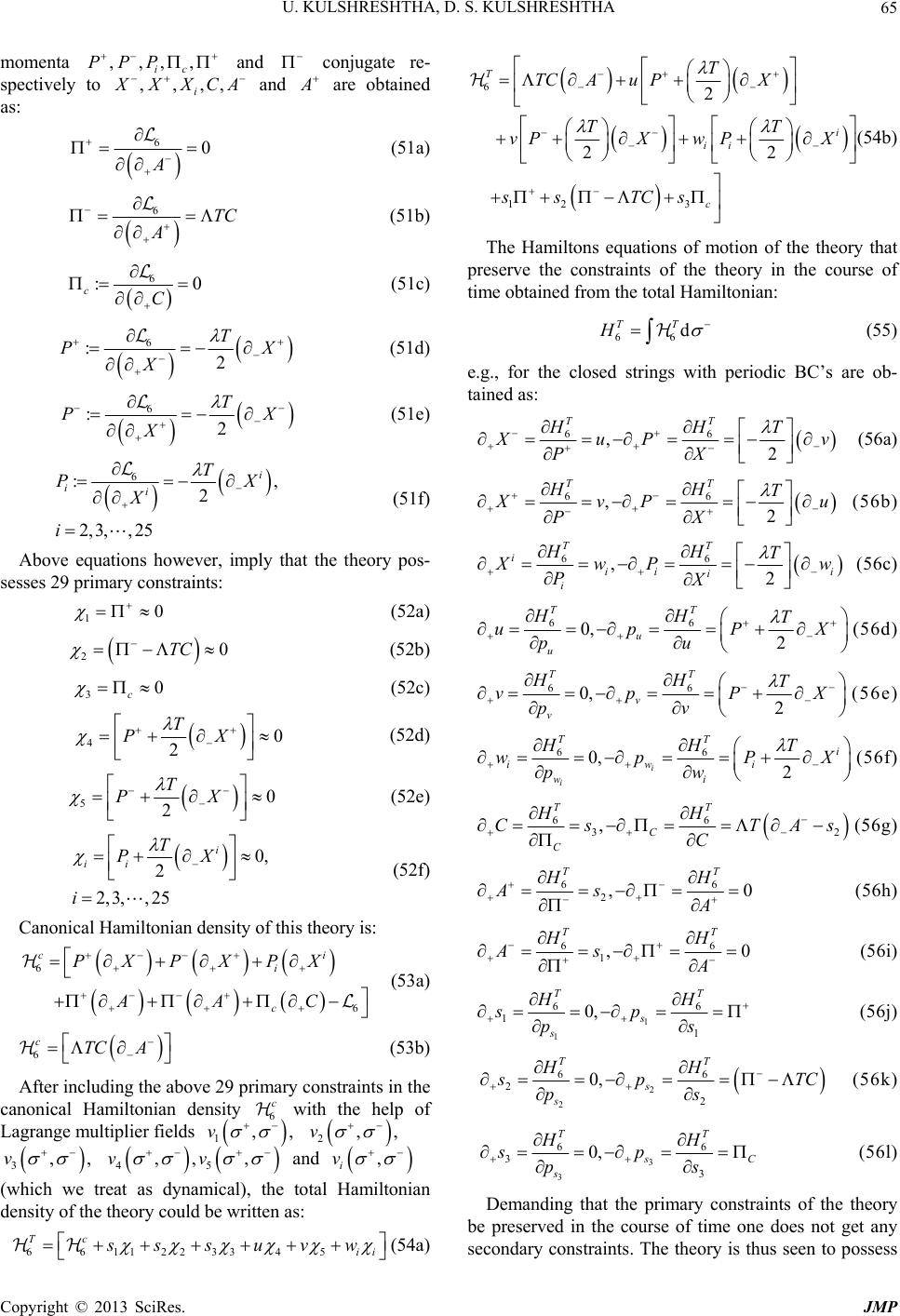 U. KULSHRESHTHA, D. S. KULSHRESHTHA 65 momenta and conjugate re- spectively to , ,,P , ,, ic , i PP , XXCA and are obtained as: 60 A (51a) 6TC A (51b) 6 :0 C c (51c) 2 T PX 6 :X (51d) 2 T PX 6 :X (51e) :, 2 i T PX 10 6 2,3, ,25 ii X i (51f) Above equations however, imply that the theory pos- sesses 29 primary constraints: 20TC 0 (52a) (52b) 3c (52c) 0 T PX 42 (52d) 0X 52 T P (52e) 0, i ii T PX 6 ci i c PXPX C 6 c 2 2,3, ,25i 6PX (52f) Canonical Hamiltonian density of this theory is: AA 6 cTC A (53a) (53b) After including the above 29 primary constraints in the canonical Hamiltonian density with the help of Lagrange multiplier fields 1,,v 2,,v 3,,v 5 ,, ,v 4 v , i and v 6611223345 ii ss suvw (which we treat as dynamical), the total Hamiltonian density of the theory could be written as: Tc (54a) 6 12 3 2 22 T i ii c T TCAu PX TT vPXw PX ss TCs 66 d TT H (54b) The Hamiltons equations of motion of the theory that preserve the constraints of the theory in the course of time obtained from the total Hamiltonian: (55) e.g., for the closed strings with periodic BC’s are ob- tained as: 66 ,2 TT HH T uP v PX (56a) 66 ,2 TT HH T vP u PX (56b) 66 ,2 TT i ii i i i HH T wP w PX (56c) 66 0, 2 TT u u HH T upPX pu (56d) 66 0, 2 TT v v HH T vpPX pv (56e) 66 0, 2 i i TT i iwi wi HH T wpPX pw (56f) 66 32 , TT C C HH Cs TAs C (56g) 66 2,0 TT HH As A (56h) 66 1,0 TT HH As A (56i) 1 1 66 11 0, TT s s HH sp ps (56j) 2 2 66 22 0, TT s s HH pTC ps (56k) 3 3 66 33 0, TT C s HH sp ps (56l) Demanding that the primary constraints of the theory be preserved in the course of time one does not get any secondary constraints. The theory is thus seen to possess Copyright © 2013 SciRes. JMP  U. KULSHRESHTHA, D. S. KULSHRESHTHA 66 only 29 constraints: 12345 ,,,, and i . Further the matrix of the Poisson brackets of these 29 constraints among themselves is easily seen to be singular, implying that the set of these 29 constarints is first-class. This in turn implies that the theory is GI (and consequently gauge anomalous). The theory is indeed seen to possess three local gauge symmetries given by the 2D WSRI and the WI defined by Equation (40). The theory could now be quantized under appropriate guage-fixing. The first-order Lagrangian density of the theory is: 12 6 123 i IO c i i ss uv CP X PX A psps pupvp 3 6 s T wi P X A ps w (57a) 62 2 IO TC sA TuX vX i i w X 0A 11 0 0TC 33 0 c (57b) To study the Hamiltonian and path integral formula- tions of the theory under gauge-fixing, we could e.g., choose the gauge: (58) corresponding to this gauge choice, the total set of con- straints of the theory under which the quantization of the theory could be studied becomes: (59a) 22 (59b) 0A (59c) 4 (59d) 0 T PX 54 2 (59e) 0 T PX 65 2 (59f) 0,2,3, ,25 i PX i PB , R 2 ii i T ,:R (59g) We now calculate the matrix of the Poisson brackets of these above 30 constraints. The nonvanishing elements of the matrix 56 65,2,3,,25 ii RRRT i 1441 2332 TRTR RRT are obtained as: (60a) R (60b) The matrix is seen to be nonsingular implying that the corresponding set of these 30 constraints is sec- ond-class. The determinant of the matrix R is given by 12 13 2 det R TT (61) R Nonvanishing elements of the inverse of this matrix 1 R (i.e. the elements of the matrix ) are: 111 56 65 1, 2 2,3, ,25 ii RRR T i (62a) 11 1 14 4123 1 32 RRTR TR (62b) with 130 30 ,,dRR 1 0A (63) Finally, following the Dirac quantization procedure in the Hamiltonian formulation, the nonvanishing ELCWST commutation relations of this theory under the gauge (with the arguments being supproted again) are obtained as: ,,,2 i i XP XP XPi (64a) ,,2 ii XXXXi T (64b) ,, 4 ii PP PPiT (64c) ,,ATACi (64d) In the path integral formulation, the transition to the quantum theory, is, however, made by writing the vac- uum to vacuum transition amplitude called the generating functional 2 i J i of the theory in the presence of ex- ternal sources as follows: 2 2 :dexpdd 2 i i i i i ZJ iJTCsA TuXvXwX (65) where the phase space variables of the theory are ,,,,,,,,,,, ii CXXXAAvv vvvv 123456 with the corresponding respective canonical conjugate momenta: 1 ,,,,, ,,,, iv PPPp ppppp 23456 i Cvvvvv . The fun- ctional measure d of the generating functional Copyright © 2013 SciRes. JMP 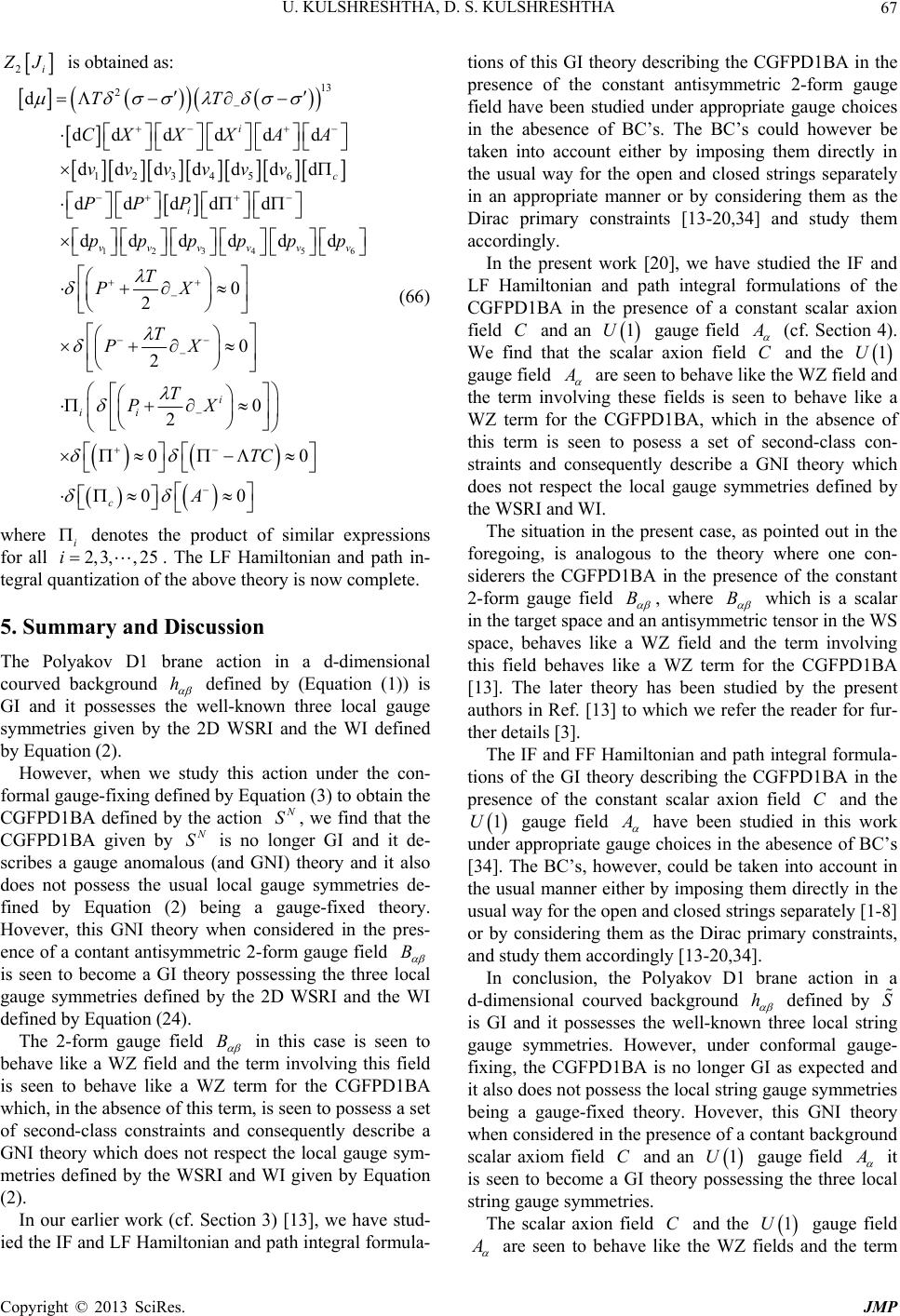 U. KULSHRESHTHA, D. S. KULSHRESHTHA 67 2i J is obtained as: 123 2 12345 d dd dd dd dddd dddd dddd 0 2 2 i i vv vv TT CX X X vvvv PPP pppp T PX T P 456 13 6 d d d d dd c v v A A vv pp 0 0 2 00 i ii c X T PX TC A 00 i 2,3, ,25 h (66) where denotes the product of similar expressions for all . The LF Hamiltonian and path in- tegral quantization of the above theory is now complete. i 5. Summary and Discussion The Polyakov D1 brane action in a d-dimensional courved background defined by (Equation (1)) is GI and it possesses the well-known three local gauge symmetries given by the 2D WSRI and the WI defined by Equation (2). However, when we study this action under the con- formal gauge-fixing defined by Equation (3) to obtain the CGFPD1BA defined by the action S, we find that the CGFPD1BA given by S is no longer GI and it de- scribes a gauge anomalous (and GNI) theory and it also does not possess the usual local gauge symmetries de- fined by Equation (2) being a gauge-fixed theory. Hovever, this GNI theory when considered in the pres- ence of a contant antisymmetric 2-form gauge field B is seen to become a GI theory possessing the three local gauge symmetries defined by the 2D WSRI and the WI defined by Equation (24). The 2-form gauge field B in this case is seen to behave like a WZ field and the term involving this field is seen to behave like a WZ term for the CGFPD1BA which, in the absence of this term, is seen to possess a set of second-class constraints and consequently describe a GNI theory which does not respect the local gauge sym- metries defined by the WSRI and WI given by Equation (2). In our earlier work (cf. Section 3) [13], we have stud- ied the IF and LF Hamiltonian and path integral formula- tions of this GI theory describing the CGFPD1BA in the presence of the constant antisymmetric 2-form gauge field have been studied under appropriate gauge choices in the abesence of BC’s. The BC’s could however be taken into account either by imposing them directly in the usual way for the open and closed strings separately in an appropriate manner or by considering them as the Dirac primary constraints [13-20,34] and study them accordingly. In the present work [20], we have studied the IF and LF Hamiltonian and path integral formulations of the CGFPD1BA in the presence of a constant scalar axion field and an 1U gauge field C (cf. Section 4). We find that the scalar axion field and the C 1U gauge field are seen to behave like the WZ field and the term involving these fields is seen to behave like a WZ term for the CGFPD1BA, which in the absence of this term is seen to posess a set of second-class con- straints and consequently describe a GNI theory which does not respect the local gauge symmetries defined by the WSRI and WI. The situation in the present case, as pointed out in the foregoing, is analogous to the theory where one con- siderers the CGFPD1BA in the presence of the constant 2-form gauge field B , where B which is a scalar in the target space and an antisymmetric tensor in the WS space, behaves like a WZ field and the term involving this field behaves like a WZ term for the CGFPD1BA [13]. The later theory has been studied by the present authors in Ref. [13] to which we refer the reader for fur- ther details [3]. The IF and FF Hamiltonian and path integral formula- tions of the GI theory describing the CGFPD1BA in the presence of the constant scalar axion field and the C 1U gauge field have been studied in this work under appropriate gauge choices in the abesence of BC’s [34]. The BC’s, however, could be taken into account in the usual manner either by imposing them directly in the usual way for the open and closed strings separately [1-8] or by considering them as the Dirac primary constraints, and study them accordingly [13-20,34]. In conclusion, the Polyakov D1 brane action in a d-dimensional courved background h defined by is GI and it possesses the well-known three local string gauge symmetries. However, under conformal gauge- fixing, the CGFPD1BA is no longer GI as expected and it also does not possess the local string gauge symmetries being a gauge-fixed theory. Hovever, this GNI theory when considered in the presence of a contant background scalar axiom field and an U gauge field S C 1 it is seen to become a GI theory possessing the three local string gauge symmetries. The scalar axion field and the U gauge field C 1 are seen to behave like the WZ fields and the term Copyright © 2013 SciRes. JMP 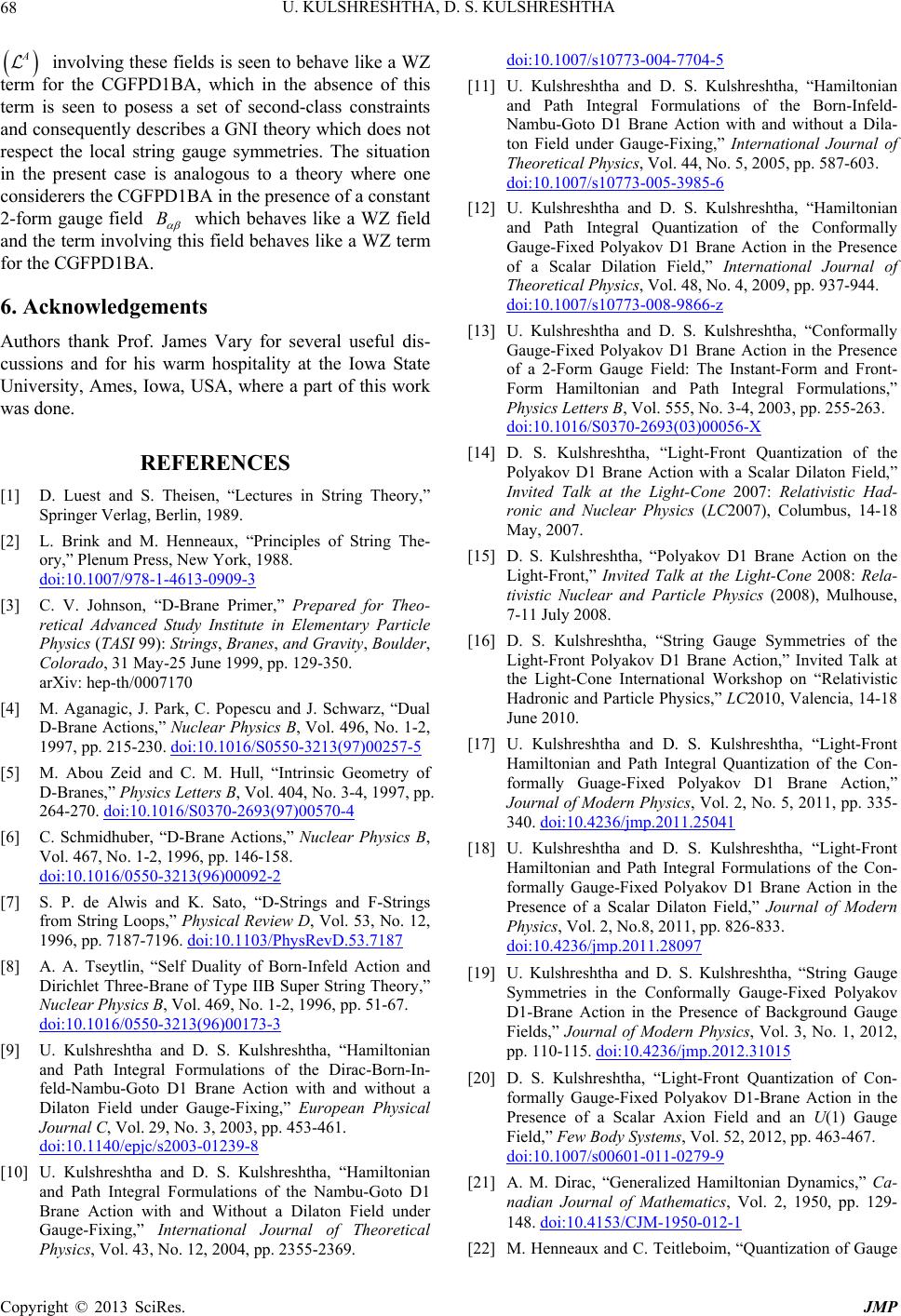 U. KULSHRESHTHA, D. S. KULSHRESHTHA 68 A B involving these fields is seen to behave like a WZ term for the CGFPD1BA, which in the absence of this term is seen to posess a set of second-class constraints and consequently describes a GNI theory which does not respect the local string gauge symmetries. The situation in the present case is analogous to a theory where one considerers the CGFPD1BA in the presence of a constant 2-form gauge field which behaves like a WZ field and the term involving this field behaves like a WZ term for the CGFPD1BA. 6. Acknowledgements Authors thank Prof. James Vary for several useful dis- cussions and for his warm hospitality at the Iowa State University, Ames, Iowa, USA, where a part of this work was done. REFERENCES [1] D. Luest and S. Theisen, “Lectures in String Theory,” Springer Verlag, Berlin, 1989. [2] L. Brink and M. Henneaux, “Principles of String The- ory,” Plenum Press, New York, 1988. doi:10.1007/978-1-4613-0909-3 [3] C. V. Johnson, “D-Brane Primer,” Prepared for Theo- retical Advanced Study Institute in Elementary Particle Physics (TA SI 99) : Strings, Branes, and Gravity, Boulder, Colorado, 31 May-25 June 1999, pp. 129-350. arXiv: hep-th/0007170 [4] M. Aganagic, J. Park, C. Popescu and J. Schwarz, “Dual D-Brane Actions,” Nuclear Physics B, Vol. 496, No. 1-2, 1997, pp. 215-230. doi:10.1016/S0550-3213(97)00257-5 [5] M. Abou Zeid and C. M. Hull, “Intrinsic Geometry of D-Branes,” Physics Letters B, Vol. 404, No. 3-4, 1997, pp. 264-270. doi:10.1016/S0370-2693(97)00570-4 [6] C. Schmidhuber, “D-Brane Actions,” Nuclear Physics B, Vol. 467, No. 1-2, 1996, pp. 146-158. doi:10.1016/0550-3213(96)00092-2 [7] S. P. de Alwis and K. Sato, “D-Strings and F-Strings from String Loops,” Physical Review D, Vol. 53, No. 12, 1996, pp. 7187-7196. doi:10.1103/PhysRevD.53.7187 [8] A. A. Tseytlin, “Self Duality of Born-Infeld Action and Dirichlet Three-Brane of Type IIB Super String Theory,” Nuclear Physics B, Vol. 469, No. 1-2, 1996, pp. 51-67. doi:10.1016/0550-3213(96)00173-3 [9] U. Kulshreshtha and D. S. Kulshreshtha, “Hamiltonian and Path Integral Formulations of the Dirac-Born-In- feld-Nambu-Goto D1 Brane Action with and without a Dilaton Field under Gauge-Fixing,” European Physical Journal C, Vol. 29, No. 3, 2003, pp. 453-461. doi:10.1140/epjc/s2003-01239-8 [10] U. Kulshreshtha and D. S. Kulshreshtha, “Hamiltonian and Path Integral Formulations of the Nambu-Goto D1 Brane Action with and Without a Dilaton Field under Gauge-Fixing,” International Journal of Theoretical Physics, Vol. 43, No. 12, 2004, pp. 2355-2369. doi:10.1007/s10773-004-7704-5 [11] U. Kulshreshtha and D. S. Kulshreshtha, “Hamiltonian and Path Integral Formulations of the Born-Infeld- Nambu-Goto D1 Brane Action with and without a Dila- ton Field under Gauge-Fixing,” International Journal of Theoretical Physics, Vol. 44, No. 5, 2005, pp. 587-603. doi:10.1007/s10773-005-3985-6 [12] U. Kulshreshtha and D. S. Kulshreshtha, “Hamiltonian and Path Integral Quantization of the Conformally Gauge-Fixed Polyakov D1 Brane Action in the Presence of a Scalar Dilation Field,” International Journal of Theoretical Physics, Vol. 48, No. 4, 2009, pp. 937-944. doi:10.1007/s10773-008-9866-z [13] U. Kulshreshtha and D. S. Kulshreshtha, “Conformally Gauge-Fixed Polyakov D1 Brane Action in the Presence of a 2-Form Gauge Field: The Instant-Form and Front- Form Hamiltonian and Path Integral Formulations,” Physics Letters B, Vol. 555, No. 3-4, 2003, pp. 255-263. doi:10.1016/S0370-2693(03)00056-X [14] D. S. Kulshreshtha, “Light-Front Quantization of the Polyakov D1 Brane Action with a Scalar Dilaton Field,” Invited Talk at the Light-Cone 2007: Relativistic Had- ronic and Nuclear Physics (LC2007), Columbus, 14-18 May, 2007. [15] D. S. Kulshreshtha, “Polyakov D1 Brane Action on the Light-Front,” Invited Talk at the Light-Cone 2008: Rela- tivistic Nuclear and Particle Physics (2008), Mulhouse, 7-11 July 2008. [16] D. S. Kulshreshtha, “String Gauge Symmetries of the Light-Front Polyakov D1 Brane Action,” Invited Talk at the Light-Cone International Workshop on “Relativistic Hadronic and Particle Physics,” LC2010, Valencia, 14-18 June 2010. [17] U. Kulshreshtha and D. S. Kulshreshtha, “Light-Front Hamiltonian and Path Integral Quantization of the Con- formally Guage-Fixed Polyakov D1 Brane Action,” Journal of Modern Physics, Vol. 2, No. 5, 2011, pp. 335- 340. doi:10.4236/jmp.2011.25041 [18] U. Kulshreshtha and D. S. Kulshreshtha, “Light-Front Hamiltonian and Path Integral Formulations of the Con- formally Gauge-Fixed Polyakov D1 Brane Action in the Presence of a Scalar Dilaton Field,” Journal of Modern Physics, Vol. 2, No.8, 2011, pp. 826-833. doi:10.4236/jmp.2011.28097 [19] U. Kulshreshtha and D. S. Kulshreshtha, “String Gauge Symmetries in the Conformally Gauge-Fixed Polyakov D1-Brane Action in the Presence of Background Gauge Fields,” Journal of Modern Physics, Vol. 3, No. 1, 2012, pp. 110-115. doi:10.4236/jmp.2012.31015 [20] D. S. Kulshreshtha, “Light-Front Quantization of Con- formally Gauge-Fixed Polyakov D1-Brane Action in the Presence of a Scalar Axion Field and an U(1) Gauge Field,” Few Body Systems, Vol. 52, 2012, pp. 463-467. doi:10.1007/s00601-011-0279-9 [21] A. M. Dirac, “Generalized Hamiltonian Dynamics,” Ca- nadian Journal of Mathematics, Vol. 2, 1950, pp. 129- 148. doi:10.4153/CJM-1950-012-1 [22] M. Henneaux and C. Teitleboim, “Quantization of Gauge Copyright © 2013 SciRes. JMP 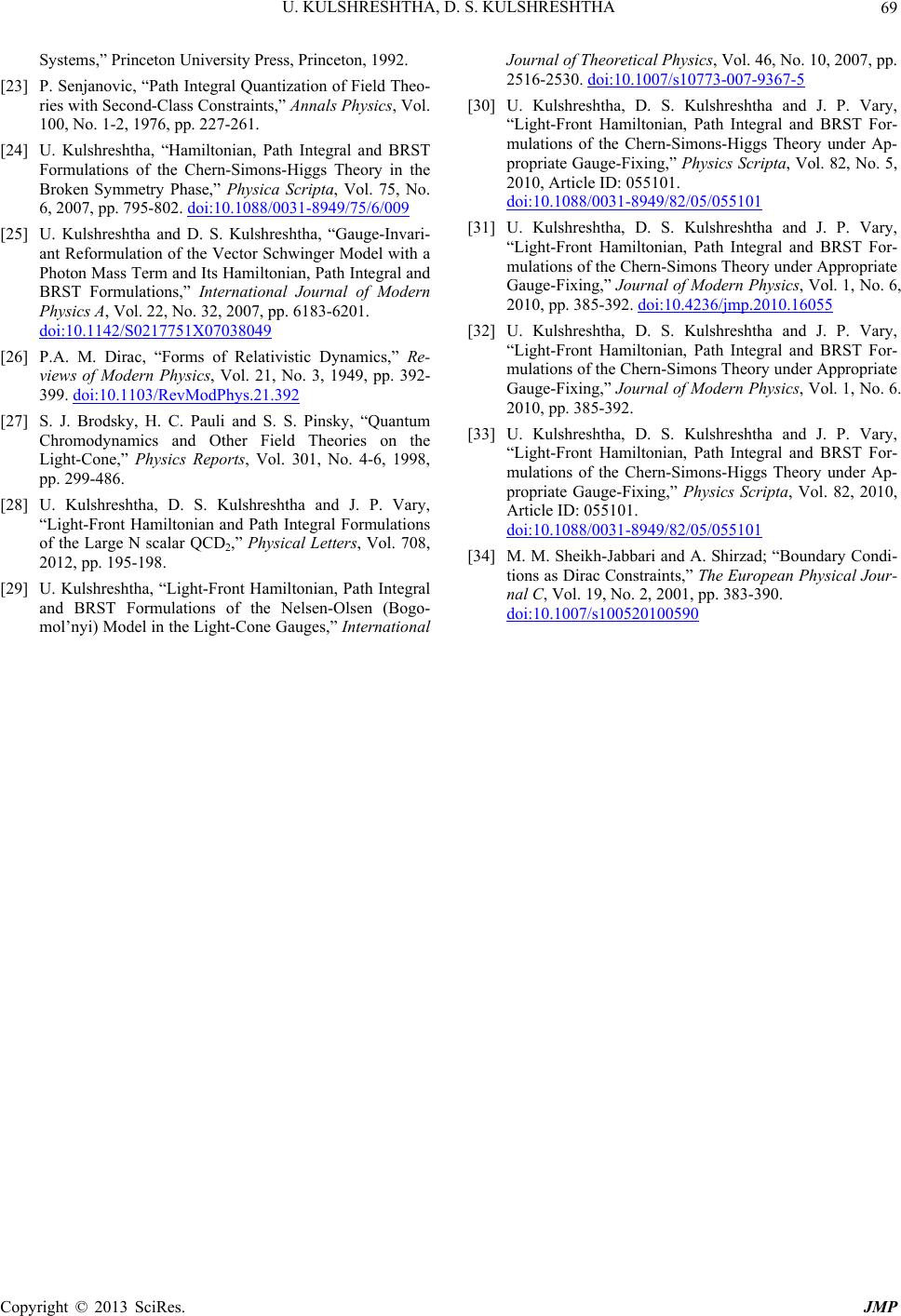 U. KULSHRESHTHA, D. S. KULSHRESHTHA Copyright © 2013 SciRes. JMP 69 Systems,” Princeton University Press, Princeton, 1992. [23] P. Senjanovic, “Path Integral Quantization of Field Theo- ries with Second-Class Constraints,” Annals Physics, Vol. 100, No. 1-2, 1976, pp. 227-261. [24] U. Kulshreshtha, “Hamiltonian, Path Integral and BRST Formulations of the Chern-Simons-Higgs Theory in the Broken Symmetry Phase,” Physica Scripta, Vol. 75, No. 6, 2007, pp. 795-802. doi:10.1088/0031-8949/75/6/009 [25] U. Kulshreshtha and D. S. Kulshreshtha, “Gauge-Invari- ant Reformulation of the Vector Schwinger Model with a Photon Mass Term and Its Hamiltonian, Path Integral and BRST Formulations,” International Journal of Modern Physics A, Vol. 22, No. 32, 2007, pp. 6183-6201. doi:10.1142/S0217751X07038049 [26] P.A. M. Dirac, “Forms of Relativistic Dynamics,” Re- views of Modern Physics, Vol. 21, No. 3, 1949, pp. 392- 399. doi:10.1103/RevModPhys.21.392 [27] S. J. Brodsky, H. C. Pauli and S. S. Pinsky, “Quantum Chromodynamics and Other Field Theories on the Light-Cone,” Physics Reports, Vol. 301, No. 4-6, 1998, pp. 299-486. [28] U. Kulshreshtha, D. S. Kulshreshtha and J. P. Vary, “Light-Front Hamiltonian and Path Integral Formulations of the Large N scalar QCD2,” Physical Letters, Vol. 708, 2012, pp. 195-198. [29] U. Kulshreshtha, “Light-Front Hamiltonian, Path Integral and BRST Formulations of the Nelsen-Olsen (Bogo- mol’nyi) Model in the Light-Cone Gauges,” International Journal of Theoretical Physics, Vol. 46, No. 10, 2007, pp. 2516-2530. doi:10.1007/s10773-007-9367-5 [30] U. Kulshreshtha, D. S. Kulshreshtha and J. P. Vary, “Light-Front Hamiltonian, Path Integral and BRST For- mulations of the Chern-Simons-Higgs Theory under Ap- propriate Gauge-Fixing,” Physics Scripta, Vol. 82, No. 5, 2010, Article ID: 055101. doi:10.1088/0031-8949/82/05/055101 [31] U. Kulshreshtha, D. S. Kulshreshtha and J. P. Vary, “Light-Front Hamiltonian, Path Integral and BRST For- mulations of the Chern-Simons Theory under Appropriate Gauge-Fixing,” Journal of Modern Physics, Vol. 1, No. 6, 2010, pp. 385-392. doi:10.4236/jmp.2010.16055 [32] U. Kulshreshtha, D. S. Kulshreshtha and J. P. Vary, “Light-Front Hamiltonian, Path Integral and BRST For- mulations of the Chern-Simons Theory under Appropriate Gauge-Fixing,” Journal of Modern Physics, Vol. 1, No. 6. 2010, pp. 385-392. [33] U. Kulshreshtha, D. S. Kulshreshtha and J. P. Vary, “Light-Front Hamiltonian, Path Integral and BRST For- mulations of the Chern-Simons-Higgs Theory under Ap- propriate Gauge-Fixing,” Physics Scripta, Vol. 82, 2010, Article ID: 055101. doi:10.1088/0031-8949/82/05/055101 [34] M. M. Sheikh-Jabbari and A. Shirzad; “Boundary Condi- tions as Dirac Constraints,” The European Physical Jour- nal C, Vol. 19, No. 2, 2001, pp. 383-390. doi:10.1007/s100520100590
|